STATE GOVERNMENT
Johnson on Worker Memorial Day: Never forget the fallen
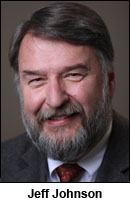 OLYMPIA (April 29, 2016) — Washington State Labor Council President Jeff Johnson delivered the following remarks at the annual Worker Memorial Day ceremony conducted at the headquarters of the state Department of Labor and Industries in Tumwater:
OLYMPIA (April 29, 2016) — Washington State Labor Council President Jeff Johnson delivered the following remarks at the annual Worker Memorial Day ceremony conducted at the headquarters of the state Department of Labor and Industries in Tumwater:
On behalf of the Washington State Labor Council, AFL-CIO and our 450,000 union members I want to thank Governor Inslee, Director Sacks, and all of the employees at Labor and Industries for continuing the tradition of celebrating Worker Memorial Day and for the work you do every day to help keep workers and our workplaces safe.
Worker Memorial Day was created by the labor movement in Canada in 1984 and was first celebrated by the AFL-CIO in the United States in 1989. Worker Memorial Day is now celebrated in hundreds of gatherings all around the world.
Today we remember and honor those workers who died on the job or from workplace exposures and pay our respects to their families.
We only get to see brief glimpses of some of the 84 workers who died in Washington State in 2015 through biographies submitted by their families.
One is immediately struck by the range of occupations they pursued, their diverse interests and skills, and the number of lives they touched and enriched. They made in a difference in this life, at work, in the community, and in their families . They will be sorely missed.
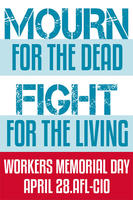 Worker Memorial Day is also a day to remember workers who have been injured on the job. But it is not enough to remember just on this day. We need to remember tomorrow and the next day, and the day after that.
Worker Memorial Day is also a day to remember workers who have been injured on the job. But it is not enough to remember just on this day. We need to remember tomorrow and the next day, and the day after that.
To help me remember I have begun wearing this pin, a canary in a birdcage, given to me by the steelworkers union. The steelworkers represent a lot of mine workers. In the 1800’s mine workers use to take canaries in birdcages with them down into the mine shafts to detect the build- up of toxic gases. If the bird got weak or died it was time to get out of the mine.
Looking at this pin each day reminds me of how important it is to think about workers’ health and safety everyday.
Worker Memorial Day is also a day to tell the truth about workplace safety in our country.
While reported workplace deaths and injuries are falling from years past, every year between 4,000 and 5,000 workers die from workplace accidents and over 50,000 die from occupational diseases that they were exposed to at the workplace.
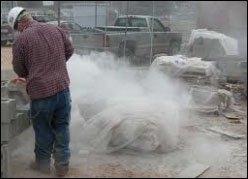 We have had some victories like the recent final adoption of the silica dust rules. Silica dust is a primary cause of silicosis and lung cancer and causes about 700 to 1,000 deaths per year.
We have had some victories like the recent final adoption of the silica dust rules. Silica dust is a primary cause of silicosis and lung cancer and causes about 700 to 1,000 deaths per year.
The rules cut silica dust exposure by half in manufacturing and more in construction: The rules are common sense:
● Cut the dust with ventilation and water
● Provide training to workers and supervisors
● Monitor dust levels at the workplace
● Medically monitor workers
But our victories are still too few and far between and often times only partial victories.
I want to give three examples of this to illustrate how much more work we have to do.
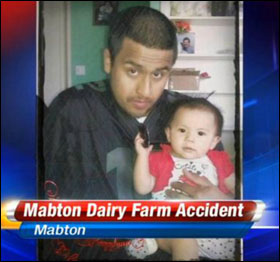 One of the names you will hear read on today’s list is Randy Vasquez, a dairy worker, who died a year ago February by drowning in a manure lagoon at the River View ranch in Mabton, WA.
One of the names you will hear read on today’s list is Randy Vasquez, a dairy worker, who died a year ago February by drowning in a manure lagoon at the River View ranch in Mabton, WA.
Randy drove a front loader at night into an unmarked, unlit and unguarded lagoon. His body wasn’t found for seven hours. To my way of thinking this constitutes gross negligence by Dairy
L&I inspected the dairy and cited the owner to the fullest extent of the law. After the appeal the fine was $ 2,300 and an agreement to fence the lagoons.
While I think that the fine is woefully inadequate, a further problem is that the fix is not precedent setting, only River View has to fence their lagoons. All manure lagoons on all dairies ought to be fenced, lit, and marked.
To add further insult, Randy’s widow and I along with the reverend Paul Benz tried to deliver 38,000 signatures to Darigold, the cooperative that River View Ranch belongs to, asking for Darigold and the union to sit down and put together a joint health and safety training program. They refused to accept the petitions and locked their headquarters doors.
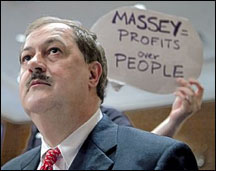 The second example happened in West Virginia earlier this month when a judge sentenced Don Blankenship, former CEO of Massey Energy, to one year in jail, one year of supervised release, and fined him $ 250,000 for the deaths of 29 coal miners in the Upper Big Branch mine explosion six years ago.
The second example happened in West Virginia earlier this month when a judge sentenced Don Blankenship, former CEO of Massey Energy, to one year in jail, one year of supervised release, and fined him $ 250,000 for the deaths of 29 coal miners in the Upper Big Branch mine explosion six years ago.
The judge said that Mr. Blankenship had “conspired to violate health and safety laws and that he created a culture of non-compliance with the law – putting productivity and profits above workers’ safety.”
His sentence was the maximum possible under the law. His lawyers of course are appealing the sentence. But even if he serves his one year in jail it amounts to 12 days in jail for every worker killed in that explosion and the fine equals $ 8,500 for each lost life.
While the law was met, justice surely was not.
The third example of how much work we have to do also happened earlier this month. OSHA brought a whistleblower suit against an Idaho company, Clearwater Paper, for $260,000 for the wrongful termination of a worker.
Three years ago , Anthony Tenney, reported to his company that there were exceedingly high levels of red cedar dust in the air. Each time he reported this he was ignored. Mr. Tenney then called OSHA who came in to do an inspection. The inspection found high levels of red cedar dust exposure.
Mr Tenney was fired 30 days after the inspection. Mr. Tenney filed a whistleblower complaint with OSHA but it took three years before the suit was filed.
The tragedy of this is two-fold: 1. Mr Tenney has suffered a loss of income which he may never recover, and 2. Given the systemic underfunding of OSHA, it would take 145 years for the inspectors at OSHA to investigate every business in the United States just one time. We need thousands of Mr Tenneys’ to stand up and point out unsafe working conditions.
All workers and supervisors should be responsible and thanked for pointing out unsafe working conditions and practices,, rather than incentivized not to report accidents through various workplace safety-bonus programs or worse yet retaliated against with demotions or loss of their job for doing the right thing.
Too often workers are unsafe at the workplace and are unsafe when they report unsafe working conditions.
This has to change. One thing we can all do is to learn about ns support the Protecting America’s Workers Act, which has been languishing in Congress for the last five years.
This Act calls for common sense changes to OSHA:
● Expanding OSHA’s coverage to millions of public employees
● Investing in health and safety training particularly for workers with limited English proficiency and older workers (workers 65 years of age and older suffer fatality rates three times greater than the average rate
● Creating strong anti-retaliation measures so workers are comfortable identifying hazards.
● Strengthening measures to prevent non-reporting of industrial accident claims and claims suppression
● Increasing civil and criminal penalties to create a real deterrent to flagrant workplace practices that put workers in harm’s way
So we have a lot of work to do to make our work places more safe
And while today, Worker Memorial Day, we remember those who have died and been injured on the job, our job tomorrow, and the next day, and the day after that is to not forget.





